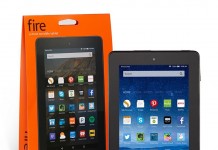
In a column I overlooked yesterday because the title wasn’t designed to grab you by the throat, Computerworld’s Steven J. Vaughan-Nichols, aka cybercinic, writes that “The forthcoming Nook Color and the rumored Amazon Kindle Tablet will bring good Linux-powered tablets to users this year after all.” Then he adds:
‘ “Sources at Amazon tell me that the company will indeed produce a mass-market Android tablet. I can’t tell you its size, pricing, when it’s expected to ship, or anything else of substance. The one thing I do know is that, like the Kindle, it will run Linux with a Java-based interface. In short, this new tablet Kindle, let’s call it “KinTablet,” will run Android. ‘
The Amazon “Welcome Packet” to prospective apps store developers, described in Engadget’s story by Chris Ziegler, contains wording that indicates to Vaughan-Nichols that what he calls a “KinTablet” may be ready in time for the holiday season. That would surprise me, but it may be that they’ve worked on this intensely for some time already. He even bets that it will be announced on the day B&N is set to launch their NookColor or the day after.
Part of that Welcome Packet story by Engadget: “Developer-submitted videos will be supported in the app product pages, which is kind of nice — neither the Android Market nor the iOS App Store support that.” They felt that the apps store would be “ready in time for the holidays” but where does the item “developer-submitted videos will be supported” fit with a Kindle reader? Would that be like the Enhanced Kindle books that only Apple products are able to use?
And there was the Kindle World story here in January, 10 months ago, citing Clayton Morris’ quote of a reply from a Qualcomm spokesman:
‘ When pressed about who its partner might be in 2010, a company spokesman asked me, “You know that device that everyone reads books on? Well, it’s going to be a game changer on a device we all know.” ‘
Now that’s a way to halt e-reader buying for 2 weeks, isn’t it. With two online ‘zines suggesting strongly that Amazon is about to release an Android tablet and this particular columnist at Computerworld citing sources at Amazon confirming a “mass-market Android tablet,” it now looks as if Amazon is actually leaking the news.
Is it to staunch the flow of orders going Barnes and Noble’s way? And even if it is, would they even talk about it to Computerworld if there wasn’t a good deal of truth to it? Is it about timing? Effect? NO hint of what kind of screen. Did they ask the sources? Is there a reason nothing’s being said about that rather important ‘area’ ?
He feels that this would be a more expensive model, as the LCD NookColor is, and was a reason that the pricing for the Kindle 3 was dropped. And what’s happening with the Kindle DX Graphite? Why hasn’t the software to it been upgraded to match the Kindle 3’s since they are sharing the same higher-contrast and faster screen technology?
The Computerworld story is written by someone who feels he knew “dedicated e-readers would die off” so there is also a whiff of wishful dynamics going on here too. First, this means he doesn’t value, himself, a dedicated e-reader, and while people like me might look forward to a GOOD e-reader tablet, in no way would I want to give up my *primary* dedicated e-book reading device.
There are too many columnists who don’t understand that and are puzzled by the extreme interest in these small, portable, HIGHLY-readable devices (something I think of everytime I pick up my Kindle 3 or DXG).
In his previous column, in June, he felt that interest in e-readers would die off in a year because a dedicated e-reader cannot compete with an iPad. That’s been shown to be nonsense. That he doesn’t even mention the differing screen technologies in EITHER column makes me wonder about his perspective and his interpretation of what was said to him.
There is a flood of buyers for dedicated e-readers at their currently decent pricing, WHILE the iPad is doing well, and he is at a loss to explain it, seeing NO reason whatsoever for that. Here are his stated reasons, which show his blindness to the attraction of paper-like screens:
‘ Everything a Nook or a Kindle can do an Apple iPad can do better. And, what’s far more important, an iPad can do far, far more.
Why should I buy a Nook or Kindle to read a book, when I can read the same books, from the same vendors, on an iPad? Or, for that matter, an iPod Touch? As Jason Perlow pointed out in his great overview of iPad e-reader applications, anything you can read on one of those devices, you can read on an iPad. ‘
He probably never goes outdoor with his ‘reader’ and his eyes are probably never in need of adjustment when reading whole books on an LCD device. Therefore the rest of the world couldn’t possibly value e-paper type screens.
Of course, everyone would prefer to spend that kind of money for screens that do irritate the eyes of many who like to read novels. I’m not talking about surfing the web (see my story yesterday on that), since I can surf the web for an entire day without eye-difficulty, as it presents eye-relief in many ways that reading a book on an LCD screen does not do for me and for many others.
And I guess some do believe that everyone would prefer to play bird-games or surf the web on their reader.
The e-reader world is a niche area — most books are still bought (heavily so) by those choosing e-Ink readers because that’s their ‘focus.’
He wrote, in June, before the recent explosion of e-reader and e-book buying, that dedicated readers … “They’re history.”
For months, other columnists have been baffled by the popularity of the dedicated devices and discovered that the iPad and dedicated e-readers seem to be complementary rather than one ‘killing’ interest in the other.
He views the idea of a supplementary device filling the needs of another target audience (one that wouldn’t want a B&W reader (and only about 10% of households make up the avid reader population, per Bezos) or who would like a *secondary* reader for magazines, travel books, children’s books) and it matches his core belief that others are like he is, wholly disinterested in reading in eye-soothing e-Ink (he doesn’t mention the technology at all which is really bizarre, since most columnists now acknowledge its attractions).
So, while I think the rumor is being dropped by Amazon intentionally, I also am sure he is misinterpreting the long-term meaning of it. Where he and I meet is if e-readers are built with screens that are usable for fast video AND for eye-pleasing e-paper (as Mirasol is), only then would people who love the new Pearl screen technology (and I am not exaggerating how much e-reader owners “love” these screens as shown in all kinds of general forums these days) move toward a tablet.
It would have to be as light, portable, and *clear* — not anything like the iPad is when it comes to reading of entire books. I know too many people who have given up reading on the iPad and gone (or returned) to dedicated e-Ink readers, and we’ve also seen the tremendous interest currently in dedicated e-readers during the height of interest in the iPad.
I was intrigued a couple of months ago that an E Ink, Inc. demo of its newer technology involving color discussed the need for making higher-contrast screens because whatever is needed to produce color e-Ink will *decrease* screen contrast. Now that I’m used to the Kindle 3 and the DX Graphite, I find it harder to use my older Kindle 2 U.S., which just looks very light, though it beats any laptop LCD screen or trying to read a book (not surf) on an iPad in daylight for any length of time.
I don’t think the answer will include E-Ink color; it’d still be too slow. It would have to be something like Qualcomm Mirasol, Pixel Qi’s dual screen capability, or one of the other emerging color screen technologies.
Interesting times.
Via Andrys Basten’s A Kindle World Blog

































Yes, I agree on all…. PS: my KDXg, i don´t need color to read, only some speed, but, i like ikn pear of KDXG.